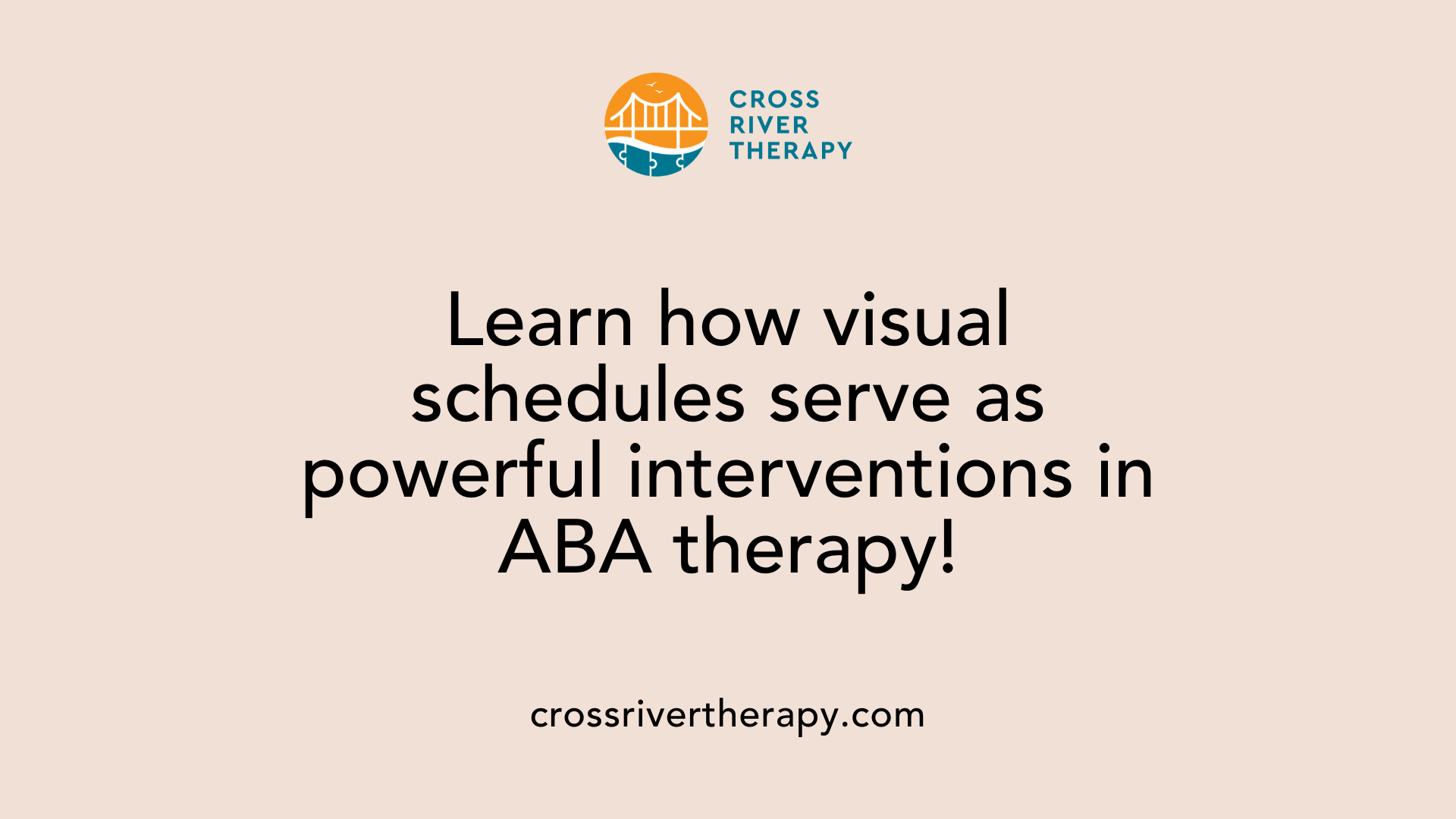The Use of Visual Schedules in ABA Therapy to Enhance Learning
Harnessing Visual Schedules for Effective ABA Therapy
Understanding Visual Schedules in ABA
In the realm of Applied Behavior Analysis (ABA) therapy, visual schedules have emerged as a pivotal tool for supporting children with autism in managing daily routines and transitions. These visual aids utilize symbols, pictures, or written words to outline expected behaviors and tasks, catering specifically to individuals who respond well to visual input. Their flexibility and ease of use make them invaluable for enhancing learning experiences in ABA settings.
The Core Components of Visual Schedules in ABA Therapy

What are visual schedules in ABA?
Visual schedules in Applied Behavior Analysis (ABA) are visual tools that aid individuals with autism in managing routines and transitions between activities. These schedules use symbols, pictures, or written words to outline expected behaviors and tasks, providing a structured approach to daily activities.
Research shows that individuals with autism often respond better to visual information, making these schedules particularly effective across various age groups, especially from late childhood through adolescence. By breaking down activities into simple steps and personalizing the visuals, visual schedules can enhance engagement and foster independence, ultimately reducing dependence on caretakers. Furthermore, they can improve functional living skills, decrease tantrums, and ease anxiety during transitions.
Components of visual schedules
Visual schedules consist of several integral components that maximize their effectiveness:
- Visual Representation: Use of pictures, symbols, or written words that represent tasks or activities.
- Structure: A clear, organized layout that allows children to understand the flow of activities throughout the day.
- Customization: Tailoring visuals to meet individual needs, developmental levels, and preferences enhances engagement.
- Consistency: Regular use of the schedule helps establish predictability, which is crucial for emotional well-being and routine adherence.
- Progress Tracking: Including indicators of completed tasks can motivate children and promote a sense of accomplishment.
By integrating these components, visual schedules not only convey what to expect but also reinforce learning, facilitate communication, and support emotional regulation.
Impact of Visual Schedules on Autism

How do visual schedules help students with autism?
Visual schedules play a crucial role for students with autism by providing clear communication about their daily activities. By using symbols and visual representations tailored to each student's comprehension level, visual schedules enhance understanding and clarity regarding routines. This predictability is essential in reducing anxiety that often arises from unpredictable situations.
Another significant advantage is the promotion of organizational skills and independence. Visual schedules help students anticipate transitions and manage their time during each task. By breaking down activities into manageable steps, students become capable of following through without constant adult prompts, leading to greater self-regulation and confidence.
Engagement is also heightened through visual schedules. These schedules serve as a motivational tool by allowing students to see what comes next and when preferred activities will occur. Consequently, they encourage participation in all tasks, even those that might initially be less enjoyable.
What are the benefits for autism-related challenges?
The use of visual schedules addresses various autism-related challenges, including anxiety and attention difficulties. By providing a structured framework, these tools help students feel more in control and less stressed during transitions, ultimately enhancing their overall emotional well-being.
Visual schedules can also promote effective communication, particularly for non-verbal students or those with expressive language delays. They facilitate a non-verbal means of interaction that allows students to engage with daily activities and request help when needed.
In educational settings, visual schedules not only support independence but also improve focus among students with autism. By offering a roadmap of tasks and expected outcomes, these schedules reinforce lessons and contribute to skill development.
| Benefit | Description |
|---|---|
| Reduces Anxiety | Provides predictability and structure. |
| Enhances Communication | Uses visual representations for clarity. |
| Promotes Independence | Allows self-management of daily activities. |
| Increases Engagement | Clarifies expectations, motivating participation. |
| Supports Skill Development | Breaks tasks into manageable steps. |
Overall, visual schedules are powerful tools that effectively address various challenges faced by students with autism, fostering a supportive environment that promotes learning and emotional resilience.
The Benefits of Implementing Visual Schedules

What are the benefits of using a visual schedule?
Using a visual schedule offers numerous benefits for children, especially in fostering independence and reducing challenging behaviors. Here are some key advantages:
- Clarity of Expectations: Visual schedules employ images and charts that clarify what is expected, greatly enhancing a child's understanding of daily routines and transitions between activities.
- Reduction of Anxiety: Predictability offered by visual schedules minimizes frustration and anxiety, which often stem from ambiguities in routines.
- Promotion of Independence: By guiding children through their tasks visually, they learn to manage their time better and anticipate changes, leading to greater self-regulation.
- Enhanced Engagement: Involving children in the creation of their visual schedules boosts their participation and commitment to following the schedule.
Broad applications
Visual schedules are versatile tools that can be applied in various settings:
| Setting | Application | Benefits |
|---|---|---|
| Home | Establish daily routines using charts and images | Increases predictability and reduces anxiety |
| School | Provide visual support for classroom activities and transitions | Enhances focus and independence |
| Therapy | Aid in understanding therapy sequences and expectations | Promotes cooperation and reduces stress |
Overall, visual schedules serve as effective tools for managing routines while supporting social-emotional development, making life easier not just for children with autism but also for caregivers.
Implementing Visual Schedules in ABA Therapy

Practical Guidance on Using Visual Schedules
Visual schedules play a crucial role in ABA therapy, especially for children with autism. They serve as a visual aid to improve comprehension and enhance engagement during therapy sessions. Here’s how to implement them effectively:
- Assess Individual Needs: Every child is unique. Start by understanding their preferences and challenges to tailor the visual schedules accordingly.
- Choose a Format: Visual schedules can take multiple forms, such as picture schedules, object schedules, photo schedules, or written formats. Select the one that aligns best with the child's learning style.
- Placement: Position the visual schedule in a prominent location where it’s easily accessible. This fosters regular reference throughout daily activities.
Steps for Effective Implementation
To ensure the successful integration of visual schedules in ABA therapy, follow these detailed steps:
- Introduce the Schedule: At the beginning of each day, review the visual schedule with the child. Discuss the day’s activities to set clear expectations.
- Highlight Changes: If there are any changes in routine, promptly point these out. Discuss how the changes will impact the day’s schedule to maintain clarity.
- Consistency is Key: Regular use of the visual schedule helps build familiarity. Consistency reinforces understanding and helps the child adapt to routines better.
- Offer Positive Reinforcement: Encourage independence by rewarding the child when they refer to and follow the visual schedule without prompt.
- Monitor and Modify: Regularly assess how well the schedule is working. Be open to making necessary changes based on the child’s responsiveness, ensuring the schedule continues to meet their evolving needs.
Employing visual schedules in this structured manner not only aids in communication but also significantly reduces anxiety associated with transitions, fostering a more productive learning environment.
Visual Schedules as ABA Interventions

Role of visual schedules as interventions
Visual schedules serve a vital function in Applied Behavior Analysis (ABA) therapy, particularly for children with Autism Spectrum Disorder (ASD) and Attention-Deficit/Hyperactivity Disorder (ADHD). These tools provide clear, visual representations of daily activities and routines, making expectations explicit. By breaking tasks down into manageable parts, visual schedules promote attention, focus, and self-regulation among children, enabling them to engage more fully in therapeutic sessions.
Using visual schedules as part of ABA interventions helps to instill a sense of structure and predictability, which is crucial for children who thrive on routine. They enhance communication by allowing children to understand and anticipate transitions, reducing anxiety related to unpredictable changes in their environment.
Research and evidence supporting use
Are visual schedules considered interventions in ABA therapy? Yes, visual schedules, particularly Visual Activity Schedule (VAS) interventions, are recognized as effective strategies within ABA therapy. Systematic reviews indicate that these interventions not only promote on-task behaviors but also boost social engagement. Research shows significant enhancements in academic performance and reductions in problem behaviors when using VAS.
The effectiveness of visual schedules is particularly pronounced in school and home settings. For example, visual schedules have been shown to improve the ability of children with ADHD to manage daily routines and foster independence. Although the quality of evidence can vary, the consistent findings underscore their importance in supporting children’s development across various domains.
| Aspect | Details | Benefit |
|---|---|---|
| Structure | Provides visual representation of tasks | Reduces anxiety and confusion |
| Engagement | Clarifies expectations for participation | Increases motivation to be involved |
| Independence | Encourages self-regulation without constant adult prompting | Fosters autonomy |
| Supports communication | Offers a non-verbal way to convey information | Essential for non-verbal individuals |
Enhancing Learning through Visual Schedules
Long-term Benefits of Visual Schedules in Learning
Visual schedules have become essential tools in enhancing learning outcomes for children, particularly those with Autism Spectrum Disorder (ASD). These schedules provide a structured visual representation of tasks, thereby promoting understanding and clarity about what is expected during learning activities. This clarity fosters improved attention spans, which are vital for effective learning.
Furthermore, the use of visual schedules supports the gradual development of independence and self-management skills. As children become accustomed to referencing their schedules, they naturally start to anticipate and manage transitions between tasks. This autonomy nurtures confidence and encourages a proactive approach to their learning journeys.
Impact on Anxiety and Independence
Children with ASD often experience heightened anxiety, particularly during transitions or unpredictable situations. Visual schedules significantly reduce this anxiety by delivering predictability and routine, allowing children to know what to expect next. By providing a clear outline of daily events, children can mentally prepare for changes, thus mitigating stress and uncertainty.
Moreover, the customizable nature of visual schedules enhances a child’s learning experience. When tailored to the individual needs of each child, these tools promote ownership and engagement, furthering their ability to manage activities independently. The long-term usage of visual schedules not only contributes to increased independence but also reinforces essential communication skills, creating a holistic approach to learning.
Conclusion
Visual schedules stand at the intersection of practical application and substantial benefits within ABA therapy, transforming how children with autism engage with their environments. By offering a structured, consistent, and understandable means of communication, these tools bolster not only the learning experiences but also the emotional and developmental outcomes for individuals. As evidence-based practices continue to validate their effectiveness, visual schedules promise to remain indispensable in enhancing learning and behavioral management for children in ABA therapy.
References
- The Importance of Visual Schedules for Individuals in Early Start ...
- Why & How to Use Visual Schedules - TherapyWorks
- Visual Calendars for Autism in ABA Therapy: Enhancing Structure ...
- Value of Visual Schedules - Explained by ABA Therapist in Fort Myers
- Visual Schedules for Autism - Brighter Strides ABA
- [PDF] Visual Schedules: A Practical Guide for Families
- [PDF] Using Visual Schedules to Establish Routines at Home
- The Efficacy of Visual Activity Schedule Intervention in Reducing ...
- Health-Related Quality of Life and Influencing Factors in Adults with ...



